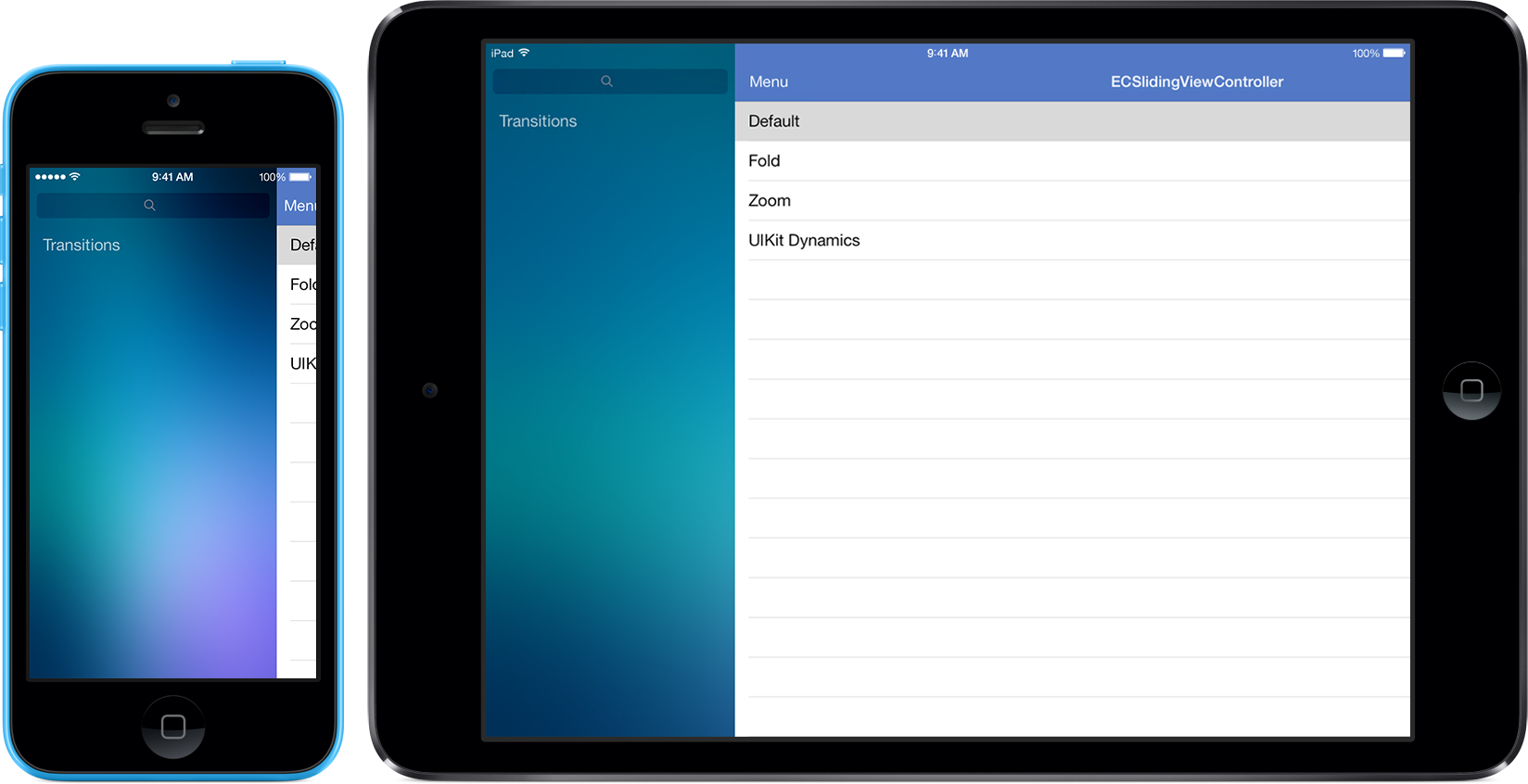ECSlidingViewController is a view controller container that manages a layered interface. The top layer anchors to the left or right side of the container while revealing the layer underneath it. This is most commonly known as the "Side Menu", "Slide Out", "Hamburger Menu/Drawer/Sidebar", etc...
Supports all screen sizes and orientations.
The philosophy behind ECSlidingViewController is to provide simple defaults while being customizable. It may not work or look the way you want out of the box, but it doesn't get in the way when customizing it.
Your view controllers will receive the appropriate view life cycle and rotation methods at the right time. Their layouts will be appropriately updated on rotation or bound changes while respecting their edgesForExtendedLayout property. This means you have control over how your view controllers position themselves under or below the status bar, navigation bar, or any other container that sets a topLayoutGuide.
ECSlidingViewController tries its best to feel like it is a part of the UIKit view controller container family, and it works when nesting any combination of them together.
Basic configuration can be done by using User Defined Runtime Attributes. ECSlidingViewController comes with a custom segue and supports unwind segues for transitioning between view controllers.
This feature is optional and everything can be done programmatically if you wanted. Just like any other view controller container, you will most likely use Storyboards with some programmatic customizations.
If the default sliding animation or swiping interaction to move the top view doesn't suit your needs, then you can customize them by providing your own.
Custom transitions use the new protocols introduced in iOS 7 while exposing an API similar to the API that the UIKit containers expose for custom transitions. You should feel right at home if you are familiar with the custom transition API in iOS 7.
- iOS 7
- Xcode 5
Note: For iOS 5-7 support, ECSlidingViewController version 1.x is available on this branch.
Install with CocoaPods by adding the following to your Podfile:
platform :ios, '7.0'
pod 'ECSlidingViewController', '~> 2.0.2'Note: We follow http://semver.org for versioning the public API.
Or copy the ECSlidingViewController/ directory from this repo into your project.
The public API is documented in the header files. It will automatically show up in Xcode 5's quick help, or you can view it online:
ECSlidingViewController Reference at cocoadocs.org
A good way to learn how to use ECSlidingViewController is to go through the example apps in Examples.xcworkspace. Each example has a README with an explanation of how things are done.
- BasicMenu. Complete example using Storyboards with minimal code.
- LayoutDemo. This is a universal app showcasing the layout.
- TransitionFun. See how custom transitions are done.
Note: There is a problem with the simulator flashing the animation when cancelling an interactive transition. This does NOT happen on the device.
The wiki contains guides that go into more detail on how to use specific features of ECSlidingViewController.
ECSlidingViewController Wiki Homepage
If you need help using ECSlidingViewController, please post a question on StackOverflow with the "ECSlidingViewController" tag. Also, the more context you can provide (such as sample projects) the easier it will be for you to get help.
If you think you found a problem with ECSlidingViewController, please post an issue. A sample project or fork of any of the examples demonstrating the problem will help us fix the issue more quickly.
Created and maintained by Mike Enriquez.
Neo Innovation (formerly known as EdgeCase) for allowing Mike to work on ECSlidingViewController on company time during its inception. He is no longer with the company, but continues to maintain the project.
And... to those of you who contributed changes or reported issues.
Copyright (c) 2013 Michael Enriquez (http://enriquez.me)
Permission is hereby granted, free of charge, to any person obtaining a copy of this software and associated documentation files (the "Software"), to deal in the Software without restriction, including without limitation the rights to use, copy, modify, merge, publish, distribute, sublicense, and/or sell copies of the Software, and to permit persons to whom the Software is furnished to do so, subject to the following conditions:
The above copyright notice and this permission notice shall be included in all copies or substantial portions of the Software.
THE SOFTWARE IS PROVIDED "AS IS", WITHOUT WARRANTY OF ANY KIND, EXPRESS OR IMPLIED, INCLUDING BUT NOT LIMITED TO THE WARRANTIES OF MERCHANTABILITY, FITNESS FOR A PARTICULAR PURPOSE AND NONINFRINGEMENT. IN NO EVENT SHALL THE AUTHORS OR COPYRIGHT HOLDERS BE LIABLE FOR ANY CLAIM, DAMAGES OR OTHER LIABILITY, WHETHER IN AN ACTION OF CONTRACT, TORT OR OTHERWISE, ARISING FROM, OUT OF OR IN CONNECTION WITH THE SOFTWARE OR THE USE OR OTHER DEALINGS IN THE SOFTWARE.
